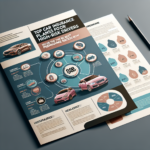Are you a driver with a less-than-perfect record? Don’t worry, you’re not alone. Many people find themselves in the high-risk category, whether due to accidents, traffic violations, or other factors. The good news is that there are still plenty of options for securing quality car insurance, even if you’re considered a high-risk driver. In this comprehensive guide, we’ll explore the best car insurance plans tailored for high-risk drivers, helping you find the coverage you need at rates that won’t break the bank.
Understanding High-Risk Driver Insurance
Before we dive into the specifics of insurance plans, it’s important to understand what exactly makes a driver “high-risk” in the eyes of insurance companies. This classification isn’t just about your driving record; it can also be influenced by factors such as your age, the type of car you drive, and even your credit score.
Insurance companies use these factors to assess the likelihood of you filing a claim. The higher the perceived risk, the higher your premiums typically are. However, this doesn’t mean you’re out of options. Many insurers specialize in high-risk policies, offering competitive rates and comprehensive coverage.
Being labeled as a high-risk driver doesn’t have to be a permanent status. With time and improved driving habits, you can work your way back to standard insurance rates. In the meantime, let’s explore how to find the best insurance plans tailored to your current situation.
Factors That Influence High-Risk Driver Insurance Rates
Several key factors play a role in determining your insurance rates as a high-risk driver. Understanding these can help you make informed decisions about your coverage and potentially find ways to reduce your premiums.
Your driving record is perhaps the most significant factor. Recent accidents, speeding tickets, or DUIs can dramatically increase your rates. Insurance companies typically look at the past three to five years of your driving history when assessing risk.
The type of vehicle you drive also impacts your insurance costs. Sports cars and luxury vehicles are often more expensive to insure due to their higher repair costs and increased likelihood of theft. Opting for a more modest, safety-focused vehicle could help lower your premiums.
Your age and driving experience play a role as well. Young drivers and those who have only recently obtained their license are often considered higher risk due to their lack of experience on the road. As you gain more years of safe driving, your rates may decrease.
Top Insurance Providers for High-Risk Drivers
Now that we understand the factors influencing high-risk insurance rates, let’s look at some of the top insurance providers that offer excellent coverage options for high-risk drivers.
Progressive is known for its willingness to insure high-risk drivers. They offer a unique program called Snapshot, which monitors your driving habits and can lead to discounts for safe driving. This can be particularly beneficial for high-risk drivers looking to prove their improved driving skills.
Progressive also offers accident forgiveness, which can prevent your rates from increasing after your first at-fault accident. This feature can provide peace of mind for those worried about the financial impact of potential future incidents.
Another great option for high-risk drivers is The General. This company specializes in providing coverage for drivers who may have trouble getting insured elsewhere. They offer flexible payment plans and accept drivers with less-than-perfect credit scores.
The General also provides SR-22 filings, which are often required for drivers with serious violations on their record. This can be a crucial service for those trying to reinstate their driving privileges after a suspension.
Comparing Insurance Plans: What to Look For
When shopping for high-risk driver insurance, it’s important to compare plans carefully. Don’t just focus on the premium; consider the coverage limits, deductibles, and additional features offered by each plan.
Look for plans that offer comprehensive and collision coverage. While these may increase your premium, they provide crucial protection in case of accidents or damage to your vehicle. Some insurers may offer these as optional add-ons for high-risk policies.
Pay attention to the policy’s liability limits. As a high-risk driver, you may want to consider higher limits to protect your assets in case of a serious accident. While this might increase your premium slightly, it could save you from significant financial trouble in the long run.
Check if the insurer offers any discounts for high-risk drivers. Some companies provide rate reductions for completing defensive driving courses or installing anti-theft devices in your vehicle. These small steps can add up to significant savings over time.
Strategies to Lower Your High-Risk Insurance Premiums
While high-risk driver insurance tends to be more expensive, there are several strategies you can employ to help lower your premiums. Implementing these tips can make a significant difference in your insurance costs over time.
One effective method is to opt for a higher deductible. By agreeing to pay more out of pocket in the event of a claim, you can often secure lower monthly premiums. Just make sure you choose a deductible amount you can comfortably afford if needed.
Another strategy is to bundle your car insurance with other policies, such as home or renter’s insurance. Many insurers offer multi-policy discounts, which can lead to substantial savings across all your insurance needs.
Consider taking a defensive driving course. Many insurance companies offer discounts to drivers who complete approved safety courses. Not only can this lower your premiums, but it can also help improve your driving skills and reduce your risk on the road.
The Impact of Credit Score on High-Risk Driver Insurance
Your credit score can have a surprising impact on your car insurance rates, especially for high-risk drivers. Many insurers use credit-based insurance scores as part of their risk assessment process, believing that individuals with higher credit scores are less likely to file claims.
If your credit score is less than ideal, focus on improving it. Pay your bills on time, reduce your credit card balances, and avoid applying for new credit unnecessarily. As your credit score improves, you may see a corresponding decrease in your insurance premiums.
Some insurers specialize in providing coverage for drivers with poor credit. While these policies may have higher premiums initially, they can provide a pathway to better rates as you work on improving your credit score.
The Role of Telematics in High-Risk Driver Insurance
Telematics, or usage-based insurance, is becoming increasingly popular, especially for high-risk drivers. This technology uses a device installed in your car or a smartphone app to monitor your driving habits, including speed, braking, and mileage.
For high-risk drivers, telematics can be a great way to prove improved driving habits and potentially earn lower rates. Many insurers offer significant discounts for participants in these programs who demonstrate safe driving behaviors.
However, it’s important to understand the privacy implications of telematics before signing up. Make sure you’re comfortable with the type and amount of data being collected about your driving habits.
Navigating SR-22 Requirements for High-Risk Drivers
If you’ve been convicted of certain serious driving offenses, you may be required to file an SR-22 form. This isn’t actually insurance, but rather a certificate that proves you have the minimum required auto insurance in your state.
Not all insurance companies offer SR-22 filings, so this is an important factor to consider when shopping for high-risk insurance. Companies like The General and Progressive, mentioned earlier, do provide this service.
Keep in mind that an SR-22 requirement typically lasts for three years, but this can vary by state and offense. During this time, it’s crucial to maintain continuous insurance coverage to avoid further penalties.
The Importance of Shopping Around for High-Risk Driver Insurance
When it comes to high-risk driver insurance, rates can vary significantly between providers. That’s why it’s crucial to shop around and get quotes from multiple insurers before making a decision.
Don’t just settle for the first quote you receive. Take the time to compare rates, coverage options, and customer reviews from several different companies. Online comparison tools can make this process easier, allowing you to see multiple quotes side by side.
Remember, the cheapest option isn’t always the best. Look for a balance between affordable premiums and quality coverage that meets your needs as a high-risk driver.
Looking Ahead: Improving Your Insurance Outlook
While being classified as a high-risk driver can be frustrating, it’s important to remember that this situation is often temporary. By maintaining a clean driving record, improving your credit score, and consistently paying your premiums on time, you can gradually work your way back to standard insurance rates.
Keep track of when violations will drop off your record, typically after three to five years. As these incidents age out, be proactive about contacting your insurer to request a rate review. You may be eligible for lower premiums sooner than you think.
Consider setting reminders to shop for new insurance quotes periodically, especially as your driving record improves. You may find that other insurers are willing to offer you better rates based on your recent history of safe driving.
Securing the right car insurance as a high-risk driver may seem challenging, but with the right approach, it’s entirely possible to find affordable coverage that meets your needs. By understanding the factors that influence your rates, comparing plans carefully, and implementing strategies to lower your premiums, you can navigate the road to better insurance with confidence. Remember, your status as a high-risk driver isn’t permanent. With time and improved driving habits, you’ll be on your way to more affordable insurance options. Stay safe on the road, and happy driving!





